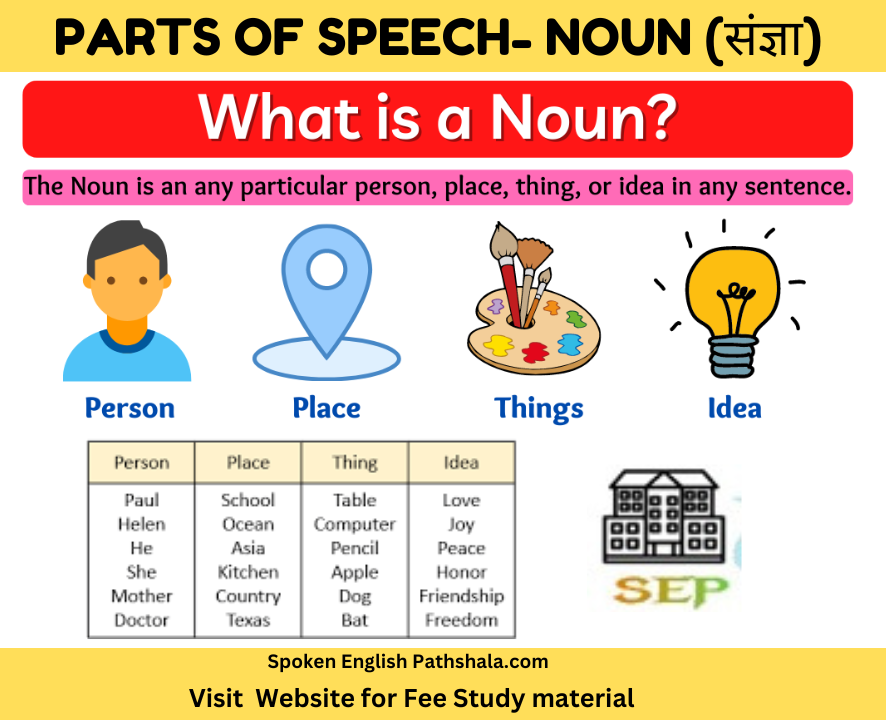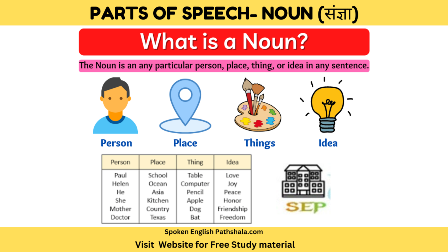welcome to our detailed exploration of nouns, a fundamental part of grammar. Whether you’re a student, a writer, or simply interested in language, understanding nouns is crucial for mastering English (or any language). Let’s delve into what nouns are, their types, functions, and some interesting aspects, with explanations in both English and Hindi.
What is a Noun? (संज्ञा क्या है?)
In grammar, a noun is a word that identifies a person, place, thing, or idea. Nouns can serve as the subject or object of a sentence, making them central to sentence structure. For instance, in the sentence “The cat sleeps on the sofa,” both “cat” and “sofa” are nouns.
व्याकरण में, संज्ञा एक शब्द होता है जो किसी व्यक्ति, स्थान, वस्तु या विचार को पहचानता है। संज्ञाएँ वाक्य के विषय या वस्तु के रूप में काम कर सकती हैं, जिससे ये वाक्य संरचना में केंद्रीय होती हैं। उदाहरण के लिए, वाक्य “बिल्ली सोफे पर सो रही है” में “बिल्ली” और “सोफा” दोनों संज्ञाएँ हैं।
Key Characteristics of Nouns (संज्ञाओं की मुख्य विशेषताएँ)
- Person (व्यक्ति): Nouns can denote people (e.g., teacher, doctor).
- उदाहरण: शिक्षक, डॉक्टर
- Place (स्थान): They can refer to locations (e.g., city, park).
- उदाहरण: शहर, पार्क
- Thing (वस्तु): Nouns can name objects (e.g., car, book).
- उदाहरण: कार, किताब
- Idea (विचार): They can also express concepts (e.g., freedom, happiness).
- उदाहरण: स्वतंत्रता, खुशी
Types of Nouns (संज्ञाओं के प्रकार)
Nouns can be categorized into several types, each serving different functions in language:
संज्ञाएँ कई प्रकार की होती हैं, जो भाषा में विभिन्न कार्य करती हैं:
1. Proper Noun (व्यक्तिवाचक संज्ञा)
Proper nouns name specific individuals, places, or organizations and are always capitalized. Examples include:
- People (व्यक्ति): Albert Einstein, Marie Curie
- Places (स्थान): Paris, Grand Canyon
- Organizations (संस्थाएँ): United Nations, Google
विशेषण संज्ञाएँ विशिष्ट व्यक्तियों, स्थानों, या संगठनों के नाम होते हैं और हमेशा बड़े अक्षरों में लिखे जाते हैं। उदाहरण: अल्बर्ट आइंस्टीन, पेरिस, संयुक्त राष्ट्र
Example
- Albert Einstein – A specific person
- Mount Everest – A specific place
- Microsoft – A specific organization
- Mona Lisa – A specific artwork
Click Here for Detailed knowledge of Proper Nouns..
2. Common Noun(जातिवाचक संज्ञा)
Common nouns refer to general items or concepts and are not capitalized unless they start a sentence. Examples include:
- People (व्यक्ति): teacher, student
- Places (स्थान): city, park
- Objects (वस्तुएँ): chair, book
- Concepts (विचार): love, justice
सामान्य संज्ञाएँ सामान्य वस्तुओं या विचारों को संदर्भित करती हैं और वाक्य की शुरुआत में बड़े अक्षरों में नहीं लिखी जाती हैं। उदाहरण: शिक्षक, शहर, कुर्सी, प्यार
Example
- Teacher – A general person
- City – A general place
- Book – A general object
- Happiness – A general concept
Click here for detailed post on common noun
3. Abstract Noun (भाववाचक संज्ञा)
Abstract nouns represent ideas, qualities, or conditions that cannot be perceived with the senses. Examples include:
- Ideas (विचार): democracy, freedom
- Qualities (गुण): bravery, beauty
- Conditions (अवस्था): happiness, sadness
अमूर्त संज्ञाएँ विचारों, गुणों, या अवस्थाओं को व्यक्त करती हैं जिन्हें इंद्रियों से महसूस नहीं किया जा सकता। उदाहरण: लोकतंत्र, साहस, खुशी
Example
- Courage – An abstract quality
- Freedom – An abstract concept
- Love – An abstract feeling
- Wisdom – An abstract quality
Click Here for detailed post on abstract Nouns
4. Concrete Nouns (ठोस संज्ञाएँ)
Concrete nouns refer to things that can be experienced through the five senses—things that can be seen, touched, heard, smelled, or tasted. Examples include:
- Objects (वस्तुएँ): apple, dog
- People (व्यक्ति): friend, neighbor
- Places (स्थान): beach, school
ठोस संज्ञाएँ उन चीज़ों को संदर्भित करती हैं जिन्हें पाँच इंद्रियों के माध्यम से अनुभव किया जा सकता है। उदाहरण: सेब, कुत्ता, समुद्र तट
Example
- Apple – A tangible object
- Dog – A tangible animal
- House – A tangible building
- Music – A tangible experience (can be heard)
Click here for Detailed post on Concrete Noun
5. Collective Nouns (संगठित संज्ञाएँ)
Collective nouns denote groups of people, animals, or things considered as a single unit. Examples include:
- People (व्यक्ति): team, family
- Animals (जानवर): herd, flock
- Things (वस्तुएँ): bunch, collection
संगठित संज्ञाएँ लोगों, जानवरों, या चीज़ों के समूह को एक इकाई के रूप में संदर्भित करती हैं। उदाहरण: टीम, परिवार, झुंड
Example
- Team – A group of people working together
- Flock – A group of birds
- Crowd – A large group of people
- Class – A group of students
Click Here for Detailed post on Collective Noun
6. Countable and Uncountable Nouns (गिनती योग्य और गिनती न होने वाली संज्ञाएँ)
Countable Nouns (गिनती योग्य संज्ञाएँ):
- These can be counted and have both singular and plural forms. Examples include:
- Singular: book, apple
- Plural: books, apples
गिनती योग्य संज्ञाएँ उन वस्तुओं को संदर्भित करती हैं जिनकी गिनती की जा सकती है और जिनके एकवचन और बहुवचन रूप होते हैं। उदाहरण: किताब, सेब
Example
- Pen – Can be counted (one pen, two pens)
- Chair – Can be counted (one chair, five chairs)
- Child – Can be counted (one child, three children)
Uncountable Nouns (गिनती न होने वाली संज्ञाएँ):
- These cannot be counted individually and typically refer to substances, concepts, or mass entities. Examples include:
- Substances: water, sugar
- Concepts: information, advice
गिनती न होने वाली संज्ञाएँ ऐसी वस्तुओं को संदर्भित करती हैं जिनकी व्यक्तिगत रूप से गिनती नहीं की जा सकती, और सामान्यतः पदार्थों, विचारों या बड़े समूहों के संदर्भ में होती हैं। उदाहरण: पानी, चीनी, जानकारी
Example
- Milk – Cannot be counted individually
- Information – Cannot be counted individually
- Rice – Cannot be counted individually
8. Compound Nouns (संयुक्त संज्ञाएँ)
Compound nouns are nouns that are made up of two or more words combined together to form a single noun with a specific meaning. These words are often joined together to create a new term that represents something distinct from the individual words on their own.
Types of Compound Nouns
- Closed Form: The words are combined into one single word without any spaces or hyphens.
- Examples: toothbrush, sunflower, football
- Hyphenated Form: The words are joined together by a hyphen.
- Examples: mother-in-law, well-being, editor-in-chief
- Open Form: The words are written separately but function together as a single noun.
- Examples: swimming pool, post office, full moon
Example of compound nouns
Toothbrush – Combination of “tooth” and “brush”
Mailbox – Combination of “mail” and “box”
Schoolbag – Combination of “school” and “bag”
9. Possessive Nouns (स्वामित्व संज्ञाएँ)
Possessive nouns are nouns that show ownership or a specific relationship between one thing and another. They are used to indicate that something belongs to someone or something.
How to Form Possessive Nouns
- Singular Nouns: For most singular nouns, you form the possessive by adding an apostrophe (
') and the letters.- Example: John → John’s (John’s book)
- Plural Nouns Ending in
s: For plural nouns that already end ins, you usually form the possessive by adding just an apostrophe (').- Example: The teachers → The teachers’ lounge (the lounge belonging to the teachers)
- Plural Nouns Not Ending in
s: For plural nouns that do not end ins, you form the possessive by adding an apostrophe ands.- Example: Children → Children’s toys (the toys belonging to the children)
Examples of Possessive Nouns
Sarah’s book – Indicates that the book belongs to Sarah
John’s car – Indicates that the car belongs to John

Functions of Nouns (संज्ञाओं के कार्य)
Nouns perform various functions in sentences, which help in conveying clear and precise meaning. The primary functions include:
संज्ञाएँ वाक्यों में विभिन्न कार्य करती हैं, जो स्पष्ट और सटीक अर्थ संप्रेषित करने में मदद करती हैं। मुख्य कार्य निम्नलिखित हैं:
1. Subject of a Sentence (वाक्य का कर्ता)
The noun performing the action or being described in a sentence is the subject. For example:
- “The dog barks loudly.” (Here, “dog” is the subject.)
वाक्य में क्रिया करने वाला या वर्णित किया जाने वाला संज्ञा कर्ता होता है। उदाहरण: “कुत्ता जोर से भौंकता है।” (यहाँ, “कुत्ता” कर्ता है।)
2. Object of a Sentence (वाक्य की वस्तु)
Nouns can also act as objects, which are usually the recipients of the action. There are two main types:
- Direct Object (प्रत्यक्ष वस्तु): Receives the action directly. Example: “She reads a book.”
- Indirect Object (अप्रत्यक्ष वस्तु): Indicates to whom or for whom the action is performed. Example: “She gave her friend a gift.”
संज्ञाएँ वस्तु के रूप में भी कार्य कर सकती हैं, जो आमतौर पर क्रिया की प्राप्तकर्ता होती हैं। दो मुख्य प्रकार हैं:
- प्रत्यक्ष वस्तु: जो क्रिया को सीधे प्राप्त करती है। उदाहरण: “वह एक किताब पढ़ती है।”
- अप्रत्यक्ष वस्तु: जो बताता है कि क्रिया किसके लिए या किसके द्वारा की जा रही है। उदाहरण: “उसने अपनी दोस्त को एक उपहार दिया।”
3. Complement (पूरक)
Nouns can function as complements, providing additional information about the subject or object. For example:
- Subject Complement (विषय पूरक): “She is a teacher.” (Here, “teacher” complements the subject “she.”)
- Object Complement (वस्तु पूरक): “They elected him president.” (Here, “president” complements the object “him.”)
संज्ञाएँ पूरक के रूप में भी कार्य कर सकती हैं, जो विषय या वस्तु के बारे में अतिरिक्त जानकारी प्रदान करती हैं। उदाहरण:
- विषय पूरक: “वह एक शिक्षक है।” (यहाँ, “शिक्षक” विषय “वह” को पूरक करता है।)
- वस्तु पूरक: “उन्हें उसे राष्ट्रपति चुना।” (यहाँ, “राष्ट्रपति” वस्तु “उसे” को पूरक करता है।)
4. Possessive Form (स्वामित्व स्वरूप)
Nouns can show ownership or possession. For example:
- “This is Sarah’s book.” (The possessive form “Sarah’s” shows that the book belongs to Sarah.)
संज्ञाएँ स्वामित्व या अधिकार को दिखा सकती हैं। उदाहरण: “यह सारा की किताब है।” (स्वामित्व स्वरूप “सारा की” दर्शाता है कि किताब सारा की है।)
Interesting Facts about Nouns (संज्ञाओं के बारे में रोचक तथ्य)
- Noun Phrases (संज्ञा वाक्यांश): Nouns often work in combination with other words to form noun phrases, which include the noun and any modifiers. For example, “the big red ball” is a noun phrase with “ball” as the noun and “the big red” as its modifiers.
संज्ञाएँ अक्सर अन्य शब्दों के साथ मिलकर संज्ञा वाक्यांश बनाती हैं, जिसमें संज्ञा और उसके विशेषण शामिल होते हैं। उदाहरण: “बड़ा लाल बॉल” एक संज्ञा वाक्यांश है जिसमें “बॉल” संज्ञा है और “बड़ा लाल” उसके विशेषण हैं।
- Plural Forms (बहुवचन रूप): While many nouns form their plural by adding “-s” or “-es” (e.g., cats, boxes), there are irregular nouns with unique plural forms, such as “child” becoming “children” and “mouse” becoming “mice.”
कई संज्ञाएँ अपने बहुवचन रूप को “-s” या “-es” जोड़कर बनाती हैं (जैसे, बिल्लियाँ, बॉक्स), लेकिन कुछ असामान्य संज्ञाएँ होती हैं जिनके बहुवचन रूप अलग होते हैं, जैसे “child” का “children” और “mouse” का “mice”।
- Compound Nouns (संयुक्त संज्ञाएँ): Some nouns are formed by combining two or more words. For instance, “toothbrush” is a compound noun made from “tooth” and “brush.”
कुछ संज्ञाएँ दो या दो से अधिक शब्दों को मिलाकर बनाई जाती हैं। उदाहरण: “टूथब्रश” एक संयुक्त संज्ञा है जो “tooth” और “brush” से बनी है।
- Gendered Nouns (लिंग आधारित संज्ञाएँ): In some languages, nouns have gender (e.g., French and Spanish). English typically uses natural gender, where nouns are gendered based on the actual gender of the person or animal they represent.
कुछ भाषाओं में संज्ञाएँ लिंग आधारित होती हैं (जैसे, फ्रेंच और स्पैनिश)। अंग्रेजी आमतौर पर प्राकृतिक लिंग का उपयोग करती है, जहाँ संज्ञाएँ व्यक्ति या जानवर के वास्तविक लिंग के आधार पर लिंगित होती हैं।
Nouns are the building blocks of sentences, helping us identify and categorize everything from tangible objects to abstract concepts. Understanding the different types of nouns and their functions not only enhances your grammatical skills but also improves your ability to communicate more effectively.
संज्ञाएँ वाक्यों की बुनियाद होती हैं, जो हमें ठोस वस्तुओं से लेकर अमूर्त विचारों तक सब कुछ पहचानने और वर्गीकृत करने में मदद करती हैं। संज्ञाओं के विभिन्न प्रकार और उनके कार्यों को समझना न केवल आपके व्याकरण कौशल को सुधारता है, बल्कि आपकी संचार क्षमता को भी बेहतर बनाता है।

